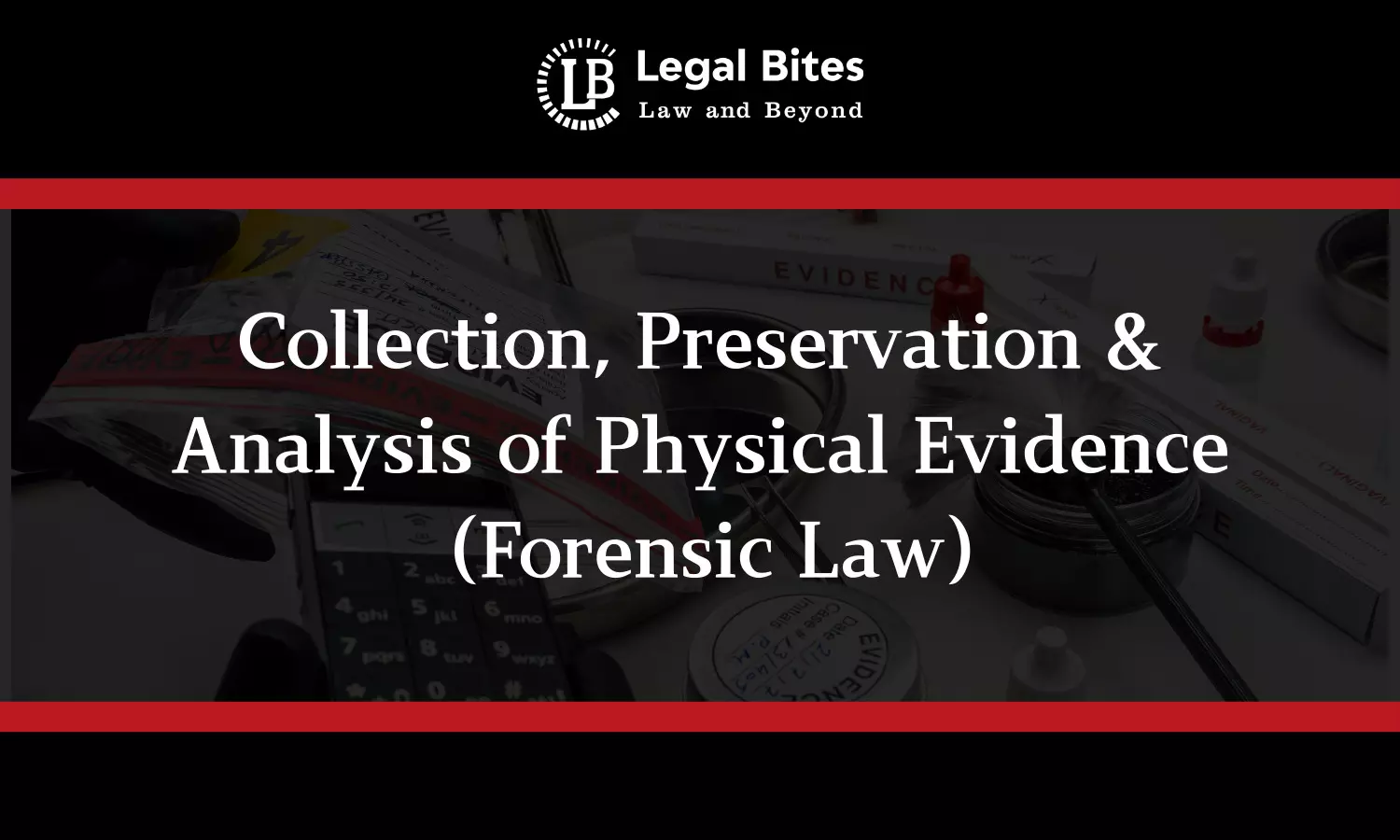Collection, Preservation, and Analysis of Physical Evidence | Forensic Law
This article explores the collection, preservation, and analysis of physical evidence in forensic law, highlighting its role in legal investigations

Forensic law serves as the backbone of criminal investigations and legal proceedings by providing scientifically-backed evidence that can help establish the facts surrounding a crime. The collection, preservation, and analysis of physical evidence are crucial for solving crimes and ensuring that justice is served. Physical evidence refers to any material object that plays a role in determining facts about a crime.
From crime scenes to laboratories, forensic experts follow strict protocols to prevent contamination and loss of evidence integrity.
Collection of Physical Evidence
1. Importance of Crime Scene Management
The first step in the forensic process is managing the crime scene. Proper crime scene management is critical to ensure that the evidence is not compromised. The crime scene must be secured and preserved to avoid contamination. Crime scene investigators (CSIs) follow standard operating procedures (SOPs), which include wearing protective clothing, using sterilized equipment, and recording the scene before evidence collection.
2. Methods of Collection
Evidence collection methods vary depending on the type of evidence. Physical evidence may include bloodstains, fingerprints, weapons, and other trace materials. Key methods of evidence collection include:
- Latent Fingerprint Collection: Dusting, chemical fuming, and lifting with tape are commonly used to collect fingerprints.
- Blood and Biological Samples: Blood and other biological fluids are carefully swabbed, air-dried, and stored in appropriate containers for further analysis.
- Impression Evidence: Footwear, tire marks, and tool marks are collected using casting materials.
- Trace Evidence Collection: Fibers, hair, paint, and soil particles are collected using tweezers, adhesive tape, or vacuum devices.
3. Chain of Custody
The chain of custody is vital in ensuring that evidence is admissible in court. It refers to the chronological documentation or paper trail that shows the seizure, custody, control, transfer, analysis, and disposition of physical evidence. Every individual who handles the evidence must document their involvement to maintain the evidence’s integrity and prevent tampering.
Preservation of Physical Evidence
1. Handling and Packaging
Proper handling and packaging are crucial to preserve physical evidence. Different types of evidence require specific storage conditions to prevent degradation. For instance, biological evidence should be air-dried and stored in paper containers rather than plastic to avoid mould growth, while trace evidence may be sealed in clean, dry containers to prevent contamination.
2. Environmental Considerations
Preserving the environmental conditions of evidence is important, especially for biological materials that can degrade due to heat, moisture, or bacterial contamination. Refrigeration or freezing is often used for biological samples, such as blood or tissue, to preserve their integrity.
3. Use of Tamper-Evident Packaging
Tamper-evident seals are used in forensic science to ensure that no unauthorized access to evidence has occurred. The seal contains unique identifiers, which are recorded in the chain of custody documentation. Any attempt to open the evidence package results in visible damage to the seal, alerting investigators to potential tampering.
Analysis of Physical Evidence
1. Forensic Laboratory Analysis
Once collected and preserved, evidence is transported to a forensic laboratory for analysis. Forensic scientists use various techniques, depending on the type of evidence. The goal is to extract as much information as possible to link a suspect to the crime or to exonerate an innocent person. Types of forensic analysis include:
- DNA Analysis: DNA profiling is used to match biological samples such as blood, saliva, or hair with a suspect.
- Ballistics Analysis: This involves examining firearms, ammunition, and gunshot residue to determine their relation to a crime.
- Toxicology: Toxicology tests determine the presence of drugs, alcohol, or poisons in biological samples.
- Fingerprint Analysis: Experts use computerized systems to compare latent fingerprints found at the crime scene with existing databases.
2. Role of Digital Forensics
In the modern era, digital evidence is becoming increasingly relevant in investigations. Digital forensics involves recovering, analyzing, and presenting data from electronic devices such as computers, smartphones, and storage media. This type of evidence is often used in cases involving cybercrime, fraud, and other digital offences.
3. Expert Testimony and Legal Implications
Forensic experts play a pivotal role in court proceedings, providing expert testimony on the analysis and results of physical evidence. Their findings help the court understand the scientific basis of the evidence and its relevance to the case. The reliability of forensic evidence, however, depends on strict adherence to scientific methodologies and standards.
Challenges in Forensic Evidence Management
1. Contamination Risks
One of the primary challenges in forensic evidence collection is the risk of contamination. Cross-contamination occurs when evidence is unintentionally transferred from one source to another, compromising its integrity. For instance, mishandling blood samples or improperly storing biological materials can lead to contamination, rendering the evidence inadmissible in court.
2. Legal Admissibility of Evidence
Forensic evidence must meet legal standards for admissibility in court. In many jurisdictions, the Daubert standard or Frye standard is used to assess whether the scientific methods applied to the evidence are reliable and accepted by the scientific community. Any deviation from established protocols can result in the exclusion of evidence.
3. Technological Advancements
Rapid advancements in technology are transforming forensic science, but they also pose new challenges. While new techniques such as Next-Generation DNA Sequencing (NGS) offer greater precision, they require proper validation before being admissible in court. Keeping up with these advancements and ensuring their legal and scientific acceptability remains a challenge for forensic experts.
Conclusion
The collection, preservation, and analysis of physical evidence are the foundation of forensic law, significantly contributing to the accuracy and reliability of criminal investigations. Effective management of evidence, from the crime scene to the courtroom, ensures that justice is served. As technology continues to evolve, forensic science will remain a crucial tool in the legal system.
However, the integrity of evidence must be preserved at all costs, and forensic experts must continually adapt to legal and technological changes to ensure the fair administration of justice.
References
[1] Saferstein, R. (2017), Criminalistics: An Introduction to Forensic Science (12th ed.)
[2] Crime Scene Investigation, Available Here
[3] Fisher, B. A. J. (2004), Techniques of Crime Scene Investigation (7th ed.)
[4] Forensic and Investigative Sciences, Available Here

